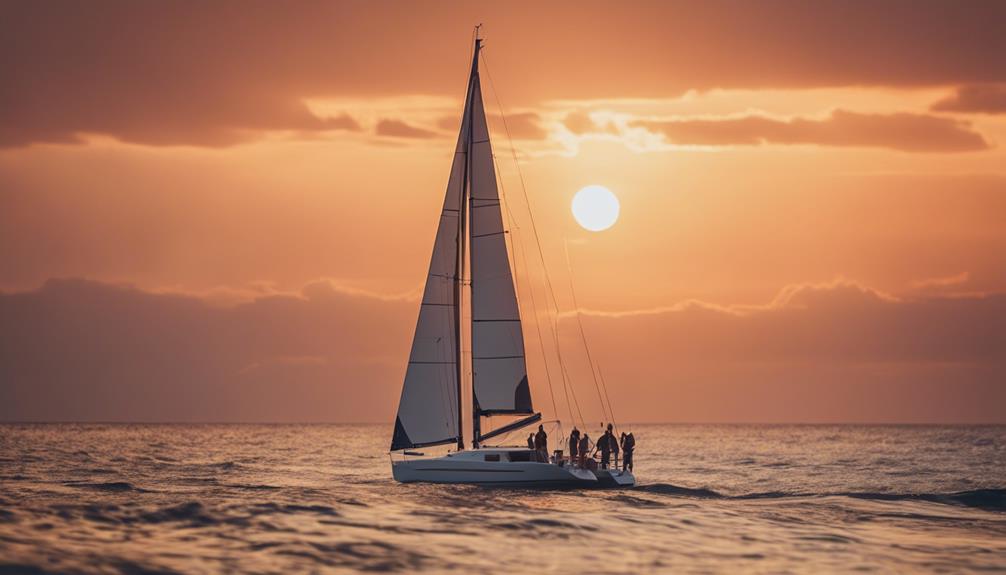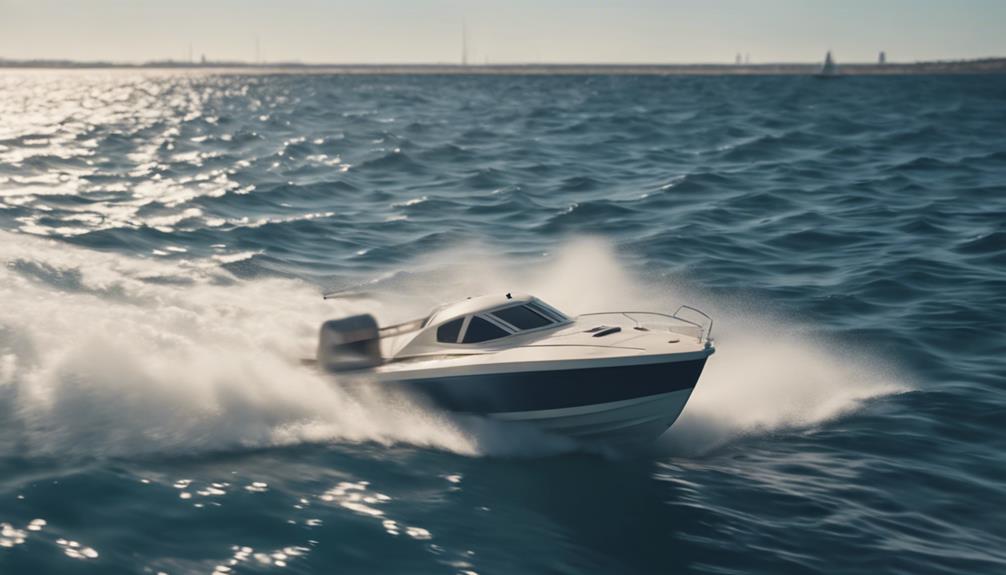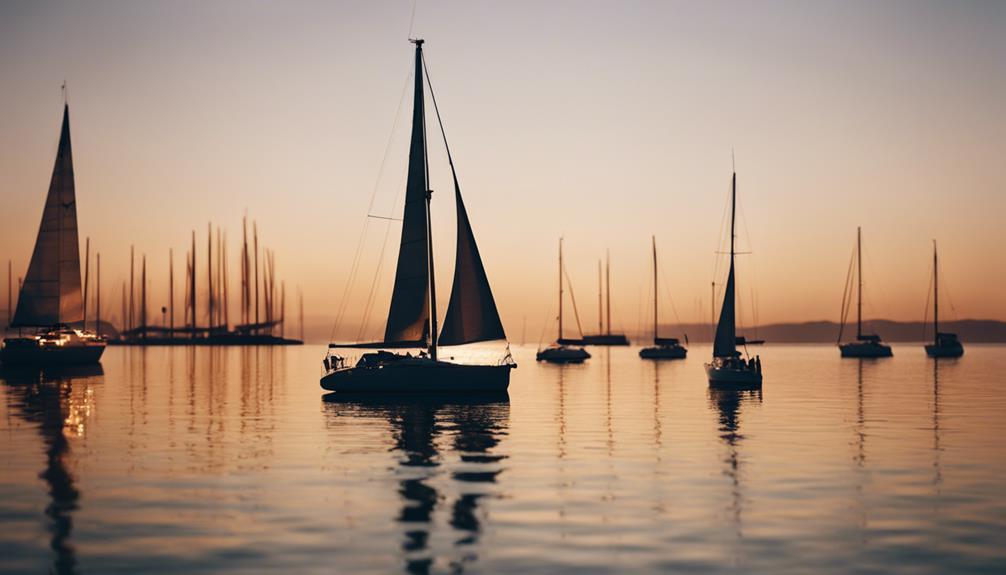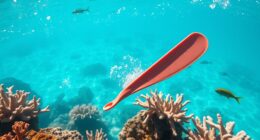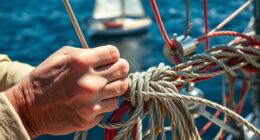When you're choosing between a sailboat and a catamaran, consider stability, comfort, and speed. Catamarans offer superior stability and perform faster due to their dual-hull design, making them ideal for families or groups. They provide spacious living areas and modern amenities, ensuring comfortable voyages. Sailboats, on the other hand, give you a more exhilarating sailing experience and are cost-effective for budget-conscious sailors. They're better suited for experienced sailors seeking thrills. Depending on your needs and budget, one may stand out. You might find the nuances particularly interesting as you continue exploring this topic.
Key Takeaways
- Catamarans offer superior stability and speed, typically sailing 20% faster than sailboats due to their dual-hull design.
- Sailboats provide an exhilarating experience with direct wind interaction, ideal for experienced sailors seeking adventure.
- Catamarans have larger living spaces and modern amenities, making them more comfortable for families and social gatherings.
- Sailboats are more cost-effective, with lower charter and maintenance fees compared to catamarans.
Stability and Performance
When comparing stability and performance, catamarans clearly excel over traditional sailboats due to their unique two-hull design, which greatly enhances stability in rough seas. This dual-hull structure minimizes the tilting motion experienced with a single hull, allowing you to sail with confidence even in challenging conditions. Catamarans maintain a beam-to-length ratio of around 50%, further improving their sailing stability without needing extra ballast.
In terms of performance, catamarans shine as well. Their hydrodynamic hulls allow for greater speed, especially when sailing upwind. You could cover distances of 200 to 250 miles a day with effective weather routing, something that's often more difficult with traditional sailboats. While sailboats may offer a thrilling and responsive experience, their tendency to heel can detract from comfort and stability.
Additionally, catamarans are typically equipped with dual engines, providing reliable propulsion and enhanced maneuverability. This advantage means you can navigate tight spaces with ease and maintain performance even if one engine fails.
Space and Comfort

When it comes to space and comfort, catamarans clearly shine with their spacious living areas and thoughtful cabin layouts.
You'll appreciate the privacy offered by separate sleeping quarters, and the modern amenities that make life on the water enjoyable.
Plus, the additional onboard features enhance your overall experience, whether you're entertaining guests or simply relaxing.
Spacious Living Areas
Catamarans offer considerably more spacious living areas than sailboats, ensuring you enjoy enhanced comfort whether you're sailing or relaxing at anchor.
With their design, catamarans provide a roomy layout, allowing for a spacious living space that encourages socializing and relaxation. Unlike traditional sailing boats, which often feature more compact and cramped settings, a catamaran lets you spread out.
You'll appreciate the separate sleeping quarters in each hull, granting you greater privacy and comfort compared to the shared arrangements typically found in sailboats. This separation allows you and your guests to enjoy personal space while still being part of the same adventure.
Additionally, the stability of catamarans minimizes tilting and rolling, making daily tasks like cooking and sleeping far more comfortable.
Modern catamarans come equipped with larger galleys and extra storage, making living onboard not just feasible but enjoyable. This enhanced comfort transforms your sailing experience, whether you're preparing a meal or unwinding after a day on the water.
In short, if you value spacious living areas and comfort, a catamaran is a compelling choice for your nautical adventures.
Cabin Layout Differences
In comparing cabin layouts, you'll find that catamarans generally offer more spacious and comfortable designs than traditional sailboats. The advantages of catamarans lie in their wider beams, allowing for generous interior space and enhanced comfort. Each hull typically houses separate sleeping quarters, providing better privacy compared to the often compact and communal living spaces of sailboats.
Here's a quick comparison to illustrate the differences:
| Feature | Catamaran | Sailboat |
|---|---|---|
| Cabin Layout | Separate cabins in each hull | Often communal sleeping areas |
| Interior Space | Larger dinettes and cockpits | Compartmentalized layouts |
| Comfort | Walk-around beds and ample storage | Efficient but less spacious |
| Advantages/Disadvantages | More privacy and comfort | Closer-knit atmosphere |
Onboard Amenities Comparison
Exploring onboard amenities reveals that catamarans typically offer more space and comfort than traditional sailboats, making them a popular choice for extended trips.
With considerably more living space, especially in boats over 12 meters, you'll enjoy larger common areas that enhance your overall sailing experience. The design of catamarans includes spacious cabins that resemble real bedrooms, often featuring walk-around beds and plenty of storage, which truly boosts your comfort while at sea.
Unlike sailboats, which tilt under wind pressure and can impact your comfort levels, catamarans maintain a stable environment. This stability reduces crew fatigue and helps prevent seasickness, making your time on board much more enjoyable.
Additionally, the amenities on catamarans elevate your experience even further. You'll find modern kitchens (galleys) equipped with ample worktop space and sophisticated appliances, allowing you to prepare meals with ease.
The higher deck on catamarans also facilitates better access for activities like diving and sunbathing, thanks to features like bow trampolines that encourage socializing and relaxation.
Fundamentally, catamarans provide an unparalleled level of comfort and convenience for your sailing adventures.
Speed and Efficiency
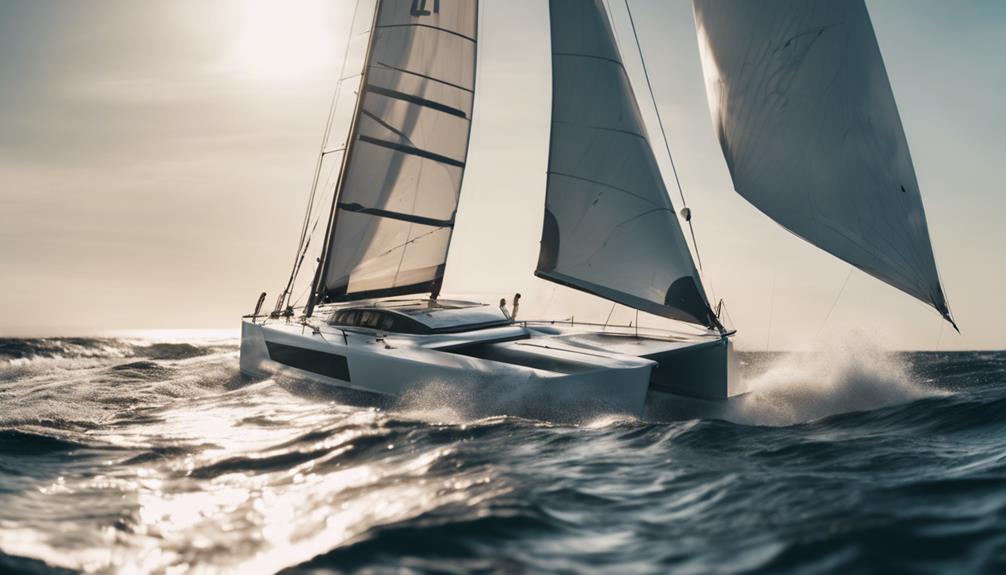
When it comes to speed, catamarans typically leave sailboats in the dust thanks to their dual hull design and lower drag.
You'll find that catamarans can sail closer to the wind, enhancing their efficiency, especially in tough conditions.
While sailboats have their charm and fuel efficiency, they just can't match the pace and performance of a well-designed catamaran.
Speed Comparison
Catamarans usually outpace sailboats due to their hydrodynamic design and reduced drag, enabling them to cover impressive distances daily. In a speed comparison, you'll find that catamarans can achieve daily travel of 200 to 250 miles with effective weather routing. Their wider beam provides enhanced stability, reducing crew fatigue and allowing faster travel than traditional sailboats, which often experience tilting motions.
Here's a quick overview of speed and performance for both types of vessels:
| Vessel Type | Average Daily Distance | Stability in Rough Seas |
|---|---|---|
| Catamaran | 200-250 miles | Excellent |
| Sailboat | 100-150 miles | Good |
| Performance | Higher | Moderate |
While sailboats can sail closer to the wind and offer a more engaging sailing experience, their overall speed typically lags behind that of catamarans. Fundamentally, if speed is your priority, a catamaran's design and performance will likely meet your needs more effectively than a traditional sailboat.
Sailing Efficiency Factors
The efficiency of a sailing vessel hinges on its design features, which greatly influence both speed and overall performance in various conditions.
When you compare catamarans and monohulls, catamarans offer distinct advantages in sailing efficiency. Their dual hulls reduce drag, which allows them to slice through water more effectively, especially when sailing upwind or in rough weather. This design enables catamarans to achieve speeds that are approximately 20% faster than their monohull counterparts.
Besides speed, the stability provided by the two hulls eliminates the need for ballast, making catamarans lighter and more agile. This feature enhances their overall performance and maneuverability, particularly in tight spaces or challenging wind conditions.
While monohulls can navigate various environments, they often struggle to match the efficiency that catamarans provide during prolonged journeys. With the ability to cover 200 to 250 miles a day when effectively routed, catamarans clearly demonstrate superior sailing efficiency that monohulls can't match.
If you're seeking speed and agility on the water, the advantages of a catamaran are hard to overlook.
Structural Differences
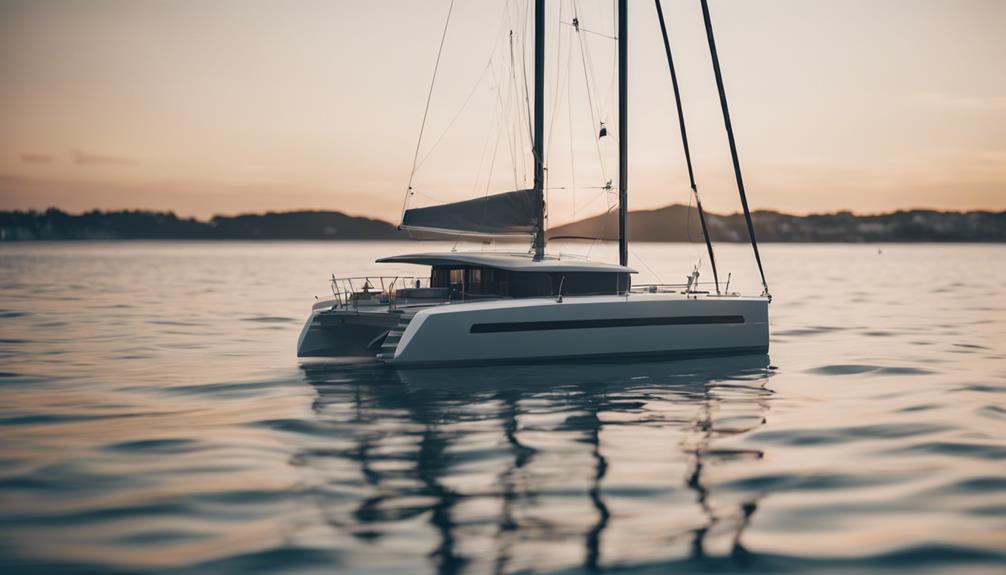
Sailboats feature a single hull design that creates a classic sailing experience, while catamarans boast two parallel hulls for enhanced stability and space. This multi-hull design allows catamarans to navigate shallower waters more effectively, making them appealing for families and those seeking comfort.
| Feature | Sailboats |
|---|---|
| Hull Type | Single hull |
| Stability | Moderate |
| Space | Limited |
| Capsizing Risk | Higher |
| Feature | Catamarans |
| Hull Type | Two parallel hulls |
| Stability | Enhanced |
| Space | More spacious |
| Capsizing Risk | Lower |
The wider beam of catamarans enhances stability, reducing the likelihood of capsizing during rough seas. While traditional sailboats prioritize performance and agility, catamarans focus on comfort and space, making them ideal for longer voyages and social activities onboard. Depending on your sailing preferences and needs, understanding these structural differences can greatly influence your choice between a sailboat and a catamaran.
Handling and Maneuverability

When maneuvering tight spaces, you'll find that catamarans offer superior handling due to their ability to turn 360 degrees on the spot. This remarkable maneuverability stems from their two engines, allowing you to navigate close quarters with ease.
Whether you're docking at a crowded marina or adjusting your position in a narrow channel, catamarans excel where sailboats may struggle.
Sailboats, equipped with a single engine, require more skill for close-quarter navigation, especially in windy conditions. Their larger turning radius can make docking and mooring more complicated, particularly during peak seasons when space is at a premium.
In contrast, the two-hull design of catamarans provides enhanced stability, reducing the impact of wind direction on your handling. This stability makes it easier to control your vessel even in adverse conditions, giving you confidence while maneuvering.
While both types of boats have their strengths, if you prioritize handling and maneuverability, especially in tight spaces, a catamaran is likely your best choice. It allows for a seamless experience, making your time on the water more enjoyable and less stressful.
Safety Considerations

Safety considerations play an essential role in choosing between a catamaran and a sailboat, as each design offers distinct advantages and challenges.
Catamarans are generally regarded as safer due to their superior stability and lower risk of capsizing. Their dual hull design provides enhanced buoyancy, making them more resistant to sinking, which can be a significant advantage in emergency situations.
On the other hand, sailboats have the ability to self-right after capsizing, a critical safety feature that can save lives. While you're sailing, the larger living space and better air circulation on a catamaran can improve safety for the crew by reducing fatigue and seasickness. However, it's crucial to recognize that the reliance on buoyancy for stability means catamarans may experience uncomfortable bridgedeck slamming in rough conditions, which could affect your comfort and alertness.
Ultimately, your choice will depend on your priorities. If maximum safety and stability in rough waters are your main concerns, a catamaran might be the better choice. If you value the ability to recover from capsizing, a sailboat could be more suitable for your needs.
Cost Comparison

Choosing between a catamaran and a sailboat often comes down to cost, as catamarans typically demand a higher investment in both charter and ownership expenses.
When you consider the price difference, catamarans generally range from €800 to €1,790 per person for charters, while sailboat charters start around €200 per day. This significant gap reflects the larger size and additional amenities of catamarans.
In terms of maintenance, catamarans also exceed sailboats in both upkeep and purchase costs, leading to higher overall expenses for ownership. You'll find that larger marina fees apply to catamarans due to their increased size, making mooring more expensive compared to narrower sailboats.
If you're a first-time sailor, budget considerations will likely favor sailboats, which offer more cost-effective options across the board.
Sailing Experiences

While cost is a significant factor in deciding between a catamaran and a sailboat, the sailing experience each vessel offers can greatly influence your choice. If you're looking for an exhilarating sailing holiday, a sailboat might be the way to go. With its one hull design, you'll feel the wind more directly, allowing for quick responses to changing conditions.
On the other hand, if you prefer a more stable and comfortable experience, a catamaran with its two rudders and dual hulls glides over the water, offering less heeling and a relaxed atmosphere.
Here's a quick comparison of the sailing experiences offered by these vessels:
| Aspect | Sailboat | Catamaran |
|---|---|---|
| Stability | Less stable | Highly stable |
| Speed Upwind | Faster | Moderate |
| Comfort Level | More tilting motion | Smooth sailing |
| Ideal for | Experienced sailors | Beginners & families |
Ultimately, your choice will depend on what sailing experience you value most. Whether it's the thrill of a sailboat or the comfort of a catamaran, both offer unique adventures on the water.
Recommendations for Choosing

When deciding between a sailboat and a catamaran, it's important to contemplate your sailing goals and preferences.
If you're a beginner looking for an authentic sailing experience, a sailboat can enhance your skills in maneuverability and handling. Sailboats are also great for budget-conscious sailors, as they typically have lower charter costs and maintenance expenses.
On the other hand, if comfort and space are your priorities—especially for family outings or social gatherings—consider a catamaran. Catamarans offer larger living areas and private cabins, which can provide a more enjoyable atmosphere for everyone on board. Additionally, they excel in stability and comfort, making them suitable for longer voyages.
Here are some recommendations to help you choose:
- Skill Level: Beginners may benefit from a sailboat to develop their sailing experience.
- Group Size: For families or groups, a catamaran's comfort and space are ideal.
Ultimately, your decision should align with your sailing style and the experiences you wish to create.
Frequently Asked Questions
What Is Better, a Catamaran or a Sailboat?
Choosing between a catamaran and a sailboat depends on your needs. If you value speed and space for family, go for a catamaran. If you prefer maneuverability and tradition, a sailboat's your best bet.
What Is the Disadvantage of Catamarans?
Catamarans have disadvantages like higher marina fees due to their width, increased maintenance costs from dual engines, and potential discomfort from bridgedeck slamming. You might also face maneuvering challenges in strong winds compared to monohulls.
Can Catamarans Handle Rough Seas?
Can catamarans handle rough seas? Absolutely! Their dual-hull design guarantees stability and buoyancy, making your journey smoother. You'll experience less tilting and reduced fatigue, allowing you to navigate challenging weather with confidence.
Is It More Difficult to Sail a Catamaran?
It can be more difficult to sail a catamaran due to unique challenges like bridgedeck slamming and sail handling, especially downwind. However, its stability and maneuverability often make it easier for beginners compared to traditional sailboats.
What are the main differences between a catamaran and a sailboat, and how do they affect your choice for your next adventure?
When considering catamaran vs sailboat for your next adventure, the main differences lie in stability and speed. Catamarans offer more stability and space, making them great for leisurely cruises or entertaining. Sailboats are better for those seeking a traditional sailing experience and enjoy the thrill of speed and agility.
Conclusion
So, which vessel is right for you—a sailboat or a catamaran?
If you crave stability and space, the catamaran's dual hulls might just win you over.
But if you're after speed and a more intimate sailing experience, a traditional sailboat could be your perfect match.
As you weigh your options and imagine the adventures ahead, one thing's for sure: the right choice could change everything.
What'll you decide when the wind calls your name?

